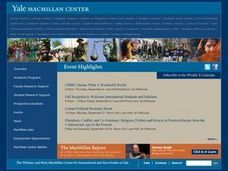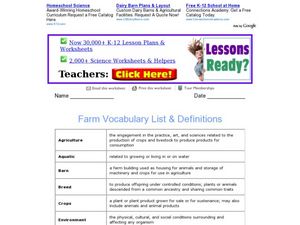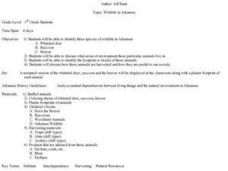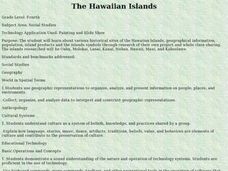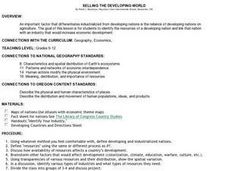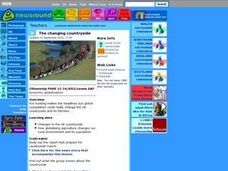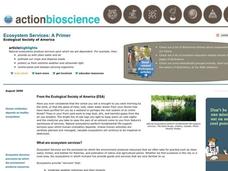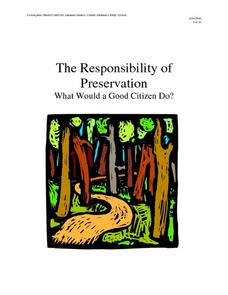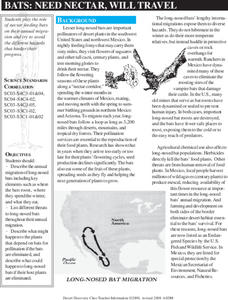Curated OER
Digital Research: The Michigan of Today
Fourth graders explore present day life in Michigan with the past. They compare information on various aspects of Michigan. Students research rural life, city life, tourism, and agriculture. They create a PowerPoint presentation on their...
Curated OER
Farming in a Fishbowl: How Ethnic Groups in
Seventh graders research Chinese agricultural needs and practices. They conduct an experiment with aquaculture and germinated rice as they take measurements and apply the scientific method.
Curated OER
Eggstra Safe Eggs
Pupils study about the bacteria that grow in eggs. They examine what farmers do to keep eggs safe such as providing clean environments in the chicken house.
Curated OER
Who In the World Is Hungry?
Students identify the scope of hunger throughout the world. Using United States data, they discover why hunger is important to the United States and its agriculture. They identify goals of sustainable development and food security. ...
Curated OER
Tee Off!
Students explore about one of the many products created by gain-based process. They investigate the ways agriculture can protect and preserve the environment. Pupils use their scientific processing skills to conduct a full inquiry based...
Curated OER
Yaks, Yurts, and Yogurt: A Look at China's Autonomous Regions
Students are introduced to five Chinese geographical areas. They, in groups, research these areas and develop presentations including information on the physical characteristics, climate, elevation, agriculture and language.
Curated OER
Hog Watch
Sixth graders assume the roles of the staff of an Environmental Regulatory Agency and must assess the amount of damage caused by hog factories. Working in groups, they make recommendations that will decrease the impact of hog factories...
Curated OER
The Common Tragedy of Consumerism
Pupils evaluate the effectiveness of current climate change solutions. In this global warming lesson, students look at the current measures implemented and analyze whether they are beneficial to the environment or not. Advance reading...
Curated OER
Farm Vocabulary List and Definitions
In this farm vocabulary worksheet, students learn 15 words pertaining to farming, agriculture and farm animals. Students read definitions for each word. There are no questions to answer.
Curated OER
Environmental Issues in South Carolina
Students research governmental agencies that deal with the environment and chart aspects about each agency. They role-play a city council meeting to address the topic of building a waste to energy facility.
Curated OER
Wildlife in Arkansas
First graders identify three species of wildlife in Arkansas. They discuss the environment in which the whitetail deer, raccoon, and beaver live in. They identify the footprints of each animal and discuss how the animals are harvested...
Curated OER
Apple Science
Sixth graders explore agriculture by viewing a fruits and vegetables video clip. In this apple characteristics lesson, 6th graders discuss how fruits and vegetables deteriorate after being exposed to oxygen and identify methods to defend...
Curated OER
The Hawaiian Islands
Fourth graders present information of people, places, and environments. They collect, organize, and analyze date to use with these representations.
Curated OER
Do we Really Need Wild Nature
Students research challenges with which modern biotechnology confronts wild nature. Students collect articles that relate to biotechnology and the environment. Students prepare a collaborative answer to the question, "Do we really need...
Curated OER
Selling the Developing World
Pupils compare and contrast the industrialized nations with the developing ones. In groups, they link a developing country with a industrialized one that could increase its economic development. They present their findings to the class...
Curated OER
The Changing countryside
Middle schoolers draw a poster showing the costs and benefits of opening up Britain's farmers to the global marketplace. They use a piece of A4 or A3 paper in landscape. Students draw a vertical line to split the page in two. On the...
Curated OER
Riparian: The Guardian of the Waterways
Students become educated on what a riparian is, the need for riparian, and how a riparian corridor (forest, habitat) can protect waterways. Students construct dioramas depicting riparian habitats.
Curated OER
How Much Is an Ecosystem Worth?
Students examine the value of ecosystems. They read and analyze an article, evaluate ecosystem services, research the benefits of biomonitors, and design a public service announcement.
Curated OER
Know Your Watershed
Students investigate the importance and the location of their own watershed by visiting and EPA website and also work in groups to create an action plan on how to protect their local watershed.
Curated OER
The Wonders of Ancient Civilizations
Bring excitement and interest to your social studies with a unit on ancient civilizations.
Roy Rosenzweig Center for History and New Media
Differences Among Colonial Regions
Classes look at and analyze primary source images to explore the differences between the colonial regions during the Revolutionary era. They break into groups to tackle each region and then present their findings to the class. A final...
Curated OER
Water: From Neglect to Respect
The goal of this collection of lessons is to make middle schoolers more aware of the ways in which they are dependent upon water to maintain their standard of living. Learners compare water use in Lesotho to water use in the United...
Curated OER
The Responsibility of Preservation
Upper elementary and middle schoolers study the case of the ivory-billed woodpecker, a bird that was once-thought to be extinct. Learners explore the responsibility of people to preserve habitats, and take care of the animals who live in...
Curated OER
Bats: Need Nectar, Will Travel
Beginning wildlife biologists become adult bats, baby bats, snakes, owls, bobcats, or land-clearing developers in a grand role-playing activity. In a large open space, they play a game in which they move to designated areas based on what...







